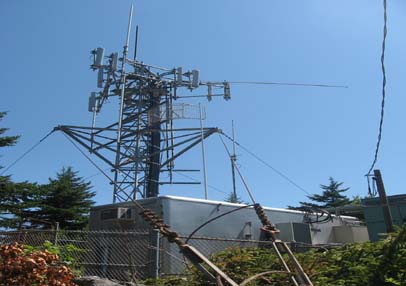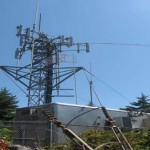
 Primary antennas for transmitting wireless telephone service, including cellular and Personal Communications Service (PCS), are usually located outdoors on towers and other elevated structures like rooftops and sides of buildings.
Primary antennas for transmitting wireless telephone service, including cellular and Personal Communications Service (PCS), are usually located outdoors on towers and other elevated structures like rooftops and sides of buildings.
The combination of antenna towers and associated electronic equipment is referred to as a “cellular or PCS cell sites” or “base station.” Cellular or PCS towers of cell sites are typically 50-200 feet high. Antennas are usually arranged in groups of three, with one antenna in each group used to transmit signals to mobile units, and the other two antennas used to receive signals from mobile units.
At the cell sites, the total radio frequency power that can be transmitted from each transmitting antenna depends on the number of radio channels (transmitters) that have been authorized by the Federal Communications Commission (FCC) and the power of each transmitter. Although the FCC permits an effective radiated power (ERP) of up to 500 watts per channel (depending on the tower height), the majority of cellular or PCS cell sites in urban and suburban areas operate at an ERP of 100 watts per channel or less and corresponds to an actual radiated power of 5-10 watts, depending on the type of antenna used. In urban areas, cell sites commonly emit an ERP of 10 watts per channel or less. For PCS cell sites, even lower ERPs are typical. As with all forms of electromagnetic energy, the power density from a cellular or PCS transmitter rapidly decreases as distance from the antenna increases.
Consequently, normal ground-level exposure is much less than the exposure that might be encountered if one were very close to the antenna and in its main transmitted beam. Measurements made near typical cellular and PCS cell sites have shown that ground-level power densities are well below the exposure limits recommended by radio frequency/microwave safety standards used by the FCC.
In the case of cellular and PCS cell sites transmitters, the FCC’s radio frequency exposure guidelines recommend a maximum permissible exposure level to the general public of approximately 580 microwatts per square centimetre. This limit is many times greater than radio frequency levels typically found near the base of cellular or PCS towers of cell sites or in the vicinity of other, lower-powered cell sites transmitters. Calculations corresponding to a “worst-case” situation (all transmitters operating simultaneously and continuously at the maximum licensed power) show that, in order to be exposed to radio frequency levels near the FCC’s guidelines, an individual would essentially have to remain in the main transmitting beam and within a few feet of the antenna for several minutes or longer. Thus, the possibility that a member of the general public could be exposed to radio frequency levels in excess of the FCC guidelines is extremely remote.
When cellular and PCS antennas are mounted on rooftops, radio frequency emissions could exceed higher than desirable guideline levels on the rooftop itself, even though rooftop antennas usually operate at lower power levels than free-standing power antennas. Such levels might become an issue for maintenance or other personnel working on the rooftop. Exposures exceeding the guidelines levels, however, are only likely to be encountered very close to and directly in front of, the antennas. In such cases, precautions such as time limits can avoid exposure in excess of the guidelines. Individuals living or working within the building are not at risk.



